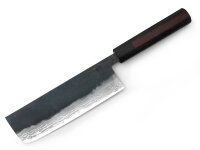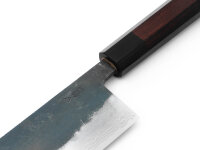
Japanese Nakiri Knives
The Nakiri Knife, Nakiri Bocho
The Nakiri vegetable knife is a Japanese knife with a wide and thin blade. The blade length is approximately 16 to 17 cm, and the shape is almost rectangular, with a double-edged blade. This shape was developed based on the Usuba Bocho, Japanese knives that, unlike the Nakiri, are sharpened only on one side. The single-edged sharpening allows for even more precise cutting, but using an Usuba requires practice and is typically suitable for right-handed individuals. The Nakiri knife, on the other hand, is optimal for both right and left-handed users.
In Japan, this knife, along with the Santoku and Yanagiba (Sushi knife, fillet knife), is among the most commonly used Japanese knives. The thin, double-edged blade of the Nakiri knife is forged at a very small angle, similar to a Santoku, and is usually extremely sharp. In this way, the Nakiri vegetable knife resembles the most popular Japanese knife, the Santoku, which is also double-edged. The purpose of the thin blade is to ensure that the cut food has as few injuries as possible and achieves a beautiful cutting pattern. This is particularly important for a vegetable knife, as presentation matters.
What is a Nakiri Knife Used For?
While the Santoku knife is an exceptionally versatile kitchen knife, the Japanese Nakiri knife was designed as a vegetable knife. Nevertheless, it is incredibly versatile. Those who aspire to become chefs in Japan are introduced to the Santoku and the single-edged Usuba vegetable knife or its double-edged successor at an early stage.
In addition to vegetables, the Nakiri chef's knife is suitable for all softer foods, herbs, salads, and even meat. The Nakiri is a fantastic tool for peeling vegetables, cutting large pieces of vegetables, and processing them into small strips, vegetable sticks, or cubes, all very efficiently after a practice phase. Anyone slicing salads into strips, such as Chinese cabbage, will quickly become fond of the Nakiri.
Furthermore, the Nakiri knife is also excellent for easily weighing herbs. It is quick, and the result will be convincing both in taste and appearance. Another application is decorative cuts. It's amazing how a skilled chef can create long strips and beautifully shaped decorative vegetable pieces from a single piece of vegetable using the Usuba with the same shape. There are no limits to the imagination for vegetable decorations. The double-edged vegetable knife is indeed an extremely versatile kitchen knife and cutting tool, excelling even the Santoku in specific applications. With its double-sided edge and wide blade, the beautiful pieces created with the Nakiri vegetable knife are quickly picked up and transferred to a bowl, pan, or wok.
So, similar to the Santoku knife, the Nakiri is a master of versatility and not in competition but rather an excellent knife pair with the Santoku for covering most cutting tasks in the kitchen.
Hand-Forged Japanese Nakiri Vegetable Knives by Oryoki
In addition to the Santoku and Gyuto, the Japanese Nakiri is one of the most popular Japanese knives in our shop. While it is a "specialist" designed as a vegetable knife, it has a wide range of applications for kitchen knives. This knife is frequently used in both private and professional kitchens as a professional knife for salads, herbs, and even meat.
Although the Usuba chef's knife (same shape, single-edged) may not appear as elegant as a Santoku knife at first glance with its wide blade, Japanese chefs have shown us that the Nakiri knife can be used for highly decorative work. We offer several variations of Nakiri vegetable knives in our range. These include Nakiri knives made from Damascus steel, Aogami Super (Kuroshiage, Nashiji), and, in our Lady Line Yuri, a beautiful, very lightweight 3-layer Nakiri with a double edge and a smoothly ground blade.
What to Consider When Buying a Nakiri Knife?
Which Nakiri knife is the best? In addition to the usual quality criteria, we believe that these points are particularly important:
- Sharpness: The sharpness potential of the steel used should be as high as possible for optimal use of the Nakiri knife. High-quality Japanese Nakiri knives, especially hand-forged Japanese knives, are made from steels that are much harder than European knife steels. Hardness levels from 60 up to 67 HRC, combined with a very well-crafted blade, offer the highest sharpness potential in the kitchen knife category. At the same time, these steels also provide edge retention significantly higher than that of European stainless steel, meaning these knives stay sharp much longer.
- Balance: The chef's knife should be well-balanced. Experienced knife smiths, whose chef's knives are particularly popular among professional chefs in Japan and Europe, pay close attention to ensuring that their knives are well-balanced. The balance of a knife is of great importance, especially for users who work extensively and quickly with the vegetable knife.
- Length: A double-edged Nakiri knife should not be too long. We consider between 16 cm and 17 cm to be ideal. Body size and existing practice play a role in the decision in this range.
- Finish: Naturally, the Nakiri knife should also be visually appealing. Personal taste determines this aspect. If the finish also helps prevent food from sticking, that's certainly an advantage, especially when working quickly. We believe that a kull finish or kull edge is particularly detrimental to the Nakiri, as the blade is very thin and should remain so, but the kullens weaken the blade. Hand-forged kitchen knives from Japan address this issue with blade finishes such as a hammered finish, bronzed blade, Kuroshiage, or Pearl Skin (Nashiji) finish. All these kitchen knife surfaces have an effective non-stick effect.
Nakiri Knives at Oryoki
Oryoki offers the following hand-forged Japanese knives in the Nakiri style. Each has its strengths. Here is an overview:
- Vegetable Knife Nakiri Yuri, blade length approx. 17.5 cm, total length 29 cm, double edge. A very lightweight knife developed by Japanese female chefs. 3 layers, High Carbon steel, "stainless steel".
- Nakiri Knife Yoshimi Kato SG2, blade length approx. 16.5 cm, total length 31 cm, sharpened on both sides. A masterpiece made of SG2 steel, a rust-resistant steel with very high sharpening potential. Very fine blade. Noble wooden handle made of olive wood.
- Series Yoshimi Kato Nashiji, blade length 16.5 cm, total length 31 cm, double-edged. Fine blade with an unusually beautiful protective finish. Very sharp, forged from Aogami Super.
- Damascus Knife Nakiri 165, Kuroshiage Nami, 12 Layers, blade length 16.5 cm, total length 31 cm, double-edged. An entry-level into Damascus knives with a rarely available Kuroshiage design. Cutting core made from Shirogami, white paper steel. Rosewood handle.
- Damascus Knife Nakiri 165, Yoshimi Kato Kurosome, 30 Layers, blade length 16 cm, total length 31 cm, double-edged. A wonderful knife with a very thin blade and very high sharpness. It glides through vegetables and creates a wonderful cutting pattern. Rosewood handle.
- Damascus Knife Nakiri White Ebony 35 Layers, Hammered. Blade length 16.5 cm, total length 31 cm, double-edged. A wonderful knife by Yoshimi Kato made from VG-10 steel with 35 layers of Damascus. An extra-class Damascus knife. The handle is made from white ebony, very rare. Comes in a high-quality Japanese wooden box.
- Usuba Aonikou Kamagata 180, Single-edged. Blade length 17 cm, total length 30.5 cm, single edge. A very high-quality classic model by Takayuki Sakai, forged from Aogami 2, blue paper steel. The handle is made from ebony, and the bolster is made from buffalo horn.
A Brief Comparison of Nakiri (Usuba) and Santoku
- Cutting Technique and Sharpness: The Santoku knife is very similar to the European chef's knife. With the Santoku, you make cutting motions by pulling, pushing, or rocking. On the other hand, the Nakiri knife is mainly used with a pushing or rocking motion. Additionally, you can "weigh" with the Nakiri, which is not recommended with the Santoku. Neither the sharp Santoku nor the sharp double-edged Nakiri requires force for fine cuts.
- Blade Shape: Compared to the Santoku knife, the Usuba has the advantage that due to its wide blade, it can be used very well to pick up the cut sticks or cubes. However, the Santoku has a tip that can be advantageous for some tasks. Both knives can be double-edged or single-edged. A traditional Usuba is single-edged, while the Nakiri is double-edged.
- Blade Thickness: As mentioned earlier, Santoku knives and Nakiri knives are very similar in that their blades are very sharp and thin, both producing a beautiful cutting pattern.
- Usage: The Santoku knife, known as the "knife of three virtues," is the better choice for most tasks involving fish and meat. The traditional single-edged Usuba vegetable knife is particularly suitable for cutting vegetables, salads, and herbs.
- Blade Length: The blade lengths of Santoku and Nakiri are similar. Longer blades, over 170mm, are more commonly found in Santoku knives.



